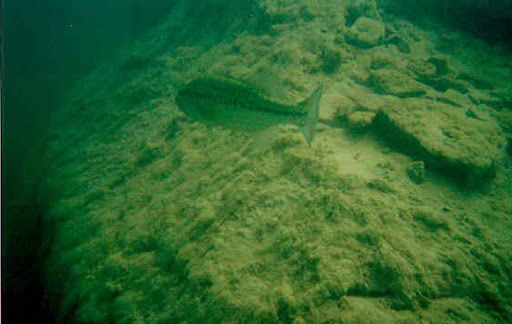Finding Bass and winter patterns
- Javius Powell
- Oct 12, 2021
- 6 min read
Updated: Aug 1
Most of the time as fishermen we gear up for the big reaction bites in the spring and summer and tend to slack off during the cooler times when the water dips below the '50s and the boat is put away as if bass pack up and take a winter vacation. If you were to get up early and see your buddy getting his boat ready for a fishing trip in late fall when the temperature is at least all of the low 60's and below, you'd probably think he was crappie fishing or crazy and wasting his time fishing for bass. It's a weird thought process that some anglers have especially new anglers, it is cold, windy, water temperature is freezing so the fish just aren't going to bite, The fish are deep, slow, and lethargic, but, they are still hungry.

When the temperature starts to dip, Bass tend to follow baitfish away from shallow areas in creeks and bays into main lake structures. Sometimes if the creek has depth bass will stay and utilize deeper structures such as points, drop-offs, deep ledges, bluff banks, and ditches that follow the lake bottom. Although seasonal patterns differ for each body of water these changes for bass don't have a set time and are not easily mapped, With many southern bass moving towards fall domains, northern bass have already seen a peak in fall patterns.
The most important thing around this time of year is keeping your eyes glued to your electronics, Best rule of thumb is to spend as much time watching your electronics just as much as fishing. knowing exactly where the fish are or are going to save time you could be used to put fish in the boat, During these stages fall patterns can be pinpointed to three or four structure points.
As many fishermen have that lake they know it's their backyard, From that loaded crappie brush pile to that 10-pound snag that took their favorite crankbait, But the guys skip right over that rock pile that holding the real 10 pounders.

The first structure that needs covering is going to be deep rock, if your fishery has a hard rocky bottom or just a few rock piles bass are going to make a B line to that structure to set up. Depending on the size of the fishery it could be all the bass or most of the bass but it will rarely be just one or two.
Fishing those rock structures during the fall and winter months can sometimes be disheartening, when you're checking each rock formation you come across, it will seem like the bass decided not to use the structure this time until you find that Single formation that has the jackpot.
When fall patterns set in bass will idolize structures that are familiar to them, and that particular place had been used before and provided great stability and forage during the winter months, not saying this is the only rock pile you're going to find bass in your fishery, but it’s going to be one to map for next season. These are situations where your big bass are going to be grouped up closer to the bottom and not moving, waiting on baitfish and you can usually fish them a little more aggressively along with finesse fishing, this time of the year you could get away throwing the bigger bait presentation and get a lot of fish going amount the school.
If you're fishing a full day and the fishery is tough, only producing one or two baits finesse fishing there isn't much risk to throwing that bigger bait. By creeping the bottom of the rock it would be the exact outcome if you're taking one or two bites on a ned rig pulling up one and two pounders, then why not take that chance on a bigger bait in hopes for a bigger bite.
The second place to look for Bass in winter depends solely on your fishery type. If you‘re fishing an area where there are elongated coves spread throughout that body of water, and the deep center section of that cove or creek arm will be the go to area. If the body of water is a rounded pond all the way across the middle of the pond and farthest from the shoreline will be the only point of intrest

These deep portions are refered to by a few names called hollows, troughs, or basins, These locations are usually featureless and mud bottoms. Some trough could have had a creek pass through the middle and exposed a lot of cover and deposting settlement such as chunk rock, but they are typically bare bottom
Bass will find these deep trenches and will get right up to the bottom and lay in the mud. It’s easy to find fish on this structure, beacuse it maps out a pattern to follow the more you fish them. If you map a group of fish at 15 feet of water, the hollow you can map bass and can catch them in roughly at the same depth.
Fishing can be exciting because it is verstile ways to catch fish wehter it‘s finesse, throwing a jig, dragging a ned rig across the bottom, or even tying onn a blade bait, all these provoke that excitement bite.
As winter patterns progress another structure Bass will utilize during the season will be hard cover. Hard cover ranges from a number of things accoriding to the type of fishery
If your fishing a river with creeks that branch out cover could be lay downs, stumps or a simple log. If your fishing lakes and ponds that cover could be boat ramps, docks, even a tire that was dropped in. When bass find the paticular cover they’re going to hug relatively close or even right next to it and depth will not alaways be an altering factor.
When fishing hardcover docks bass will tend to hang on the end of the dock,but most of the bigger bass are going to hang out just a few feet off the dock closer to open water. If the dock sits at around ten feet of water there are going to be bass directly at the end of the dock but the bigger bass are going to be in water around 12-13 feet of water.
The only time bass are going to hug directly to cover is if the water depth doesnt taper off into deeper water, when choosing the right cover to make that cast to, key tip is to pick a peice of cover in a good area that jutting out of the water.
Whatever the cover may be, structure that portrudes out of the water act as a space heater for bass during winter allowing Bass to stay warm. The peice of cover out of the water heats up and the heat travels through,although its a subtle change in temparture it’s a difference fish can feel.
In whether the Bass are schooled on a submerged brush pile or a stick poking out the water. These can sometiems be shallowand the best ways to fish are jerk baits and jigs. Throwing that slower presnation allows for the fish to hone in on your bait without expending any energy.
The long pasues between twitches lets the bass get close without a chase and as the bait sits there is suspended in their face and that twitch triggers the reaction strike and can rile up two or three in a single school.
The other way are jigs. Open hollows allows for you to throwing a jig across the muddy bottoms, you‘re able to fish them slow or give a smaller prenstation for a slower suspernsion, keeping the bait in the strike zone a little longer.
Weather and water level changes is the last focul point of winter pattern to follow. A minimal adjust in water level depth wont have any effect on the fishing pattern, but if water levels drop dragsticly the fish are going to rise and to deeper parts. This pattern is the tougher aspect of trying to locate the bass. Although the deeper parts don't change, weather can affect where the bass will find cover as the water lowers.
On the oppsite when the weather permits drastic risning water, this will increase your change of catching Bass right up the banks and other shallower areas. As the water rises Areas around it become flooded withh water allowing thedse fish to travel in other areas and access to other food sources.
When this happens you‘re going to be able to fish many different ways to catch fish such as power fishing or jigs. As the water changes, you should be able to adapt to go with bolder or darker profile baits to get those fish to notice your bait as they adapt as well. If the water has been stained for an extended period of time the profile and presentation won’t matter as much the bass are going to be well adapted to their conditions.
Winter and fall patterns have a tough transitons os many anglers, Knowing where to look is going to be half the battle, But once you know where they are and how to fish it the winter funs begins and produces some big Bass. The Bass dont dissappear and they are still hungry, This is the time of year to take that chance on that bigger bait for that 12 pond trophy so if your not fishing your missing big opportunities.




Comments